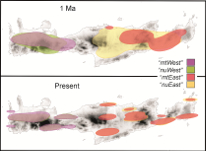IS16050Testing species delimitation with larval morphology: scanning electron microscopy analysis of protonymphon larvae of two closely related sea spiders, Pallenopsis patagonica (Hoek) and Pallenopsis yepayekae Weis

Protonymphon larvae of numerous sea spiders have as yet not been described, and therefore it is not clear whether their sets of characters allow for differential diagnoses. Using the resolving power of scanning electron microscopy, our analysis of protonymphons of two closely related species of Pallenopsis reveals various species-specific larval characters. Protonymphon features are thus significant in the context of species delimitation and can be used as idependent sets of characters in addition to adult morphology and DNA sequences.










